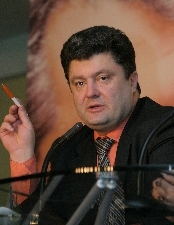
POROSHENKO DRAFTS, YUSHCHENKO LAUNCHES A PLAN FOR TRANSNISTRIA
Publication: Eurasia Daily Monitor Volume: 2 Issue: 82
By:

Ukraine’s National Security and Defense Council (NSDC) Secretary, Petro Poroshenko, has prepared a Transnistria settlement proposal that embarrassed President Viktor Yushchenko at the April 22 GUAM summit. The proposals disrupted the event (see EDM, April 25, 26), raised questions about Kyiv’s willingness to overcome certain sequels of the Kuchma era, and set back Ukraine’s stated goal to become a “regional leader” in the Black Sea region.
Poroshenko prevailed on Yushchenko to use the GUAM summit for unveiling the proposal, after Poroshenko had sidelined the Ministry of Foreign Affairs to handle the Transnistria issue himself. It is a unilateral Ukrainian proposal, but Poroshenko cleared it with his Russian counterpart, Igor Ivanov, in Moscow on the day before the GUAM summit, and Russia’s embassy in Chisinau endorsed it publicly on the day of the summit (Itar-Tass, April 21, 22).
The seven-point proposal, in the works in Kyiv for the last two months, stipulates the following:
1. “Ukraine proposes to the Administration of Transnistria to create conditions for development of democracy, civil society, and a multiparty system”;
2. “Elections to be held soon to Transnistria’s Supreme Soviet, the representative body of the Transnistria region of Moldova, on the basis of a legal status of Transnistria”;
3. “The European Union, OSCE, Council of Europe, Russia, the United States [listed in that order] to participate alongside Ukraine in monitoring the free and democratic elections to Transnistria’s Supreme Soviet”;
4. “Ukraine supports the intentions of the European Union and the United States to contribute to the solution of the problem of Transnistria”;
5. “The existing peacekeeping format to be transformed into an international mechanism of military and civilian observers under OSCE aegis”;
6. “The Administration of Transnistria to allow an international monitoring mission, with the participation of Ukrainian specialists, to military-industrial enterprises in the region”; and
7. “Ukraine is prepared to consent to short-term monitoring of the Ukraine-Moldova border by OSCE teams from Ukrainian territory, with a view to checking the movement of goods and people. We call on Transnistria to take similar steps.”
The omissions generated as much comment during the summit as did the actual content of the proposal. It makes no mention of Russia’s troops in Transnistria and obligation to withdraw them; and it seemingly ignores the Transnistria army (Russian under Transnistria’s flag) and the Moscow-controlled internal security apparatus there. Such omissions implicitly suggest that the proposed elections are to be held in the presence of those forces. The proposal makes no reference to Moldova’s sovereignty, constitution, and political system, and mentions the name of Moldova once altogether.
Points 1, 2, and 3 seemingly expect Transnistria’s incumbent authorities to conduct free and democratic elections, and “soon.” Ukrainian delegates suggested informally that the elections could be held in a matter of months (September to December 2005 were mentioned as possible dates). However, absent political parties, civil-society structures, free media, and all the other prerequisites, and with a population whose only political experience is that of Soviet-type voting (after 1991 as well), and Russian state television its main source of information, the quick-fix elections could only return the incumbent authorities to power. Such elections would merely legitimize the existing “Administration of Transnistria,” a new term launched by this proposal, and implying at least de facto recognition (under Point 6 as well). At most, such elections may result in replacing some individuals in Tiraspol’s leadership, but not the system and structures of power there.
Point 4 stops far short of envisaging a full-fledged political role for the European Union and the United States in the settlement. It excludes Moldova’s neighbor and next-of-kin Romania, even as Kyiv justifies its own role by citing geographic proximity and concern for the Ukrainian minority. Point 5 would significantly improve on the existing situation; but the OSCE is too discredited by its 12-year track record, and too dependent now on Russia for its sheer survival, to sponsor such a mission in Transnistria. Point 5 initially envisaged (and the Ukrainian side also mentioned verbally) the possibility of deploying a 600-strong Ukrainian battalion to Transnistria.
Points 6 and 7 seem to envisage only sporadic monitoring (short of intrusive inspections), without an actual monitoring mechanism. Implementation seems subject to Transnistria authorities’ consent (fully so for the military factories, partly so for customs). No reference is made to Russia’s vast arsenals, though they are as likely as “Transnistrian” factories to feed the illegal arms trade.
Point 7 ignores Moldova’s lawful customs authority. The proposed “short-term monitoring” and “checking” would not stop the illicit trade through “Europe’s largest black hole.” It would allow Transnistria to continue massively exporting and re-exporting goods, subject only to “checking” (presumably for arms and drugs). The proposed sequencing — political solution at the outset, customs measures at the end of the process — would maintain Tiraspol’s bargaining power, instead of weakening it through serious border controls and proceeding only afterward to the political stage.
The European Union has been asking Ukraine since 2001 to close the black hole on that border. The Kuchma regime refused or eschewed the EU’s demarches. Many suspected at the time — and some in the new Ukrainian authorities are certain — that corrupt officials in the Odessa oblast and in Kyiv took their cut from Transnistria’s illicit trade, which also created political complicities that persist between Tiraspol and elements in Ukraine’s authorities. Initially, the new leadership in Kyiv declared that it was prepared to stop the illicit trade on that border. It briefly introduced some restrictions, but lifted them in March, when Poroshenko’s Council took over the lead role on the Transnistria issue from the Foreign Affairs Ministry.




